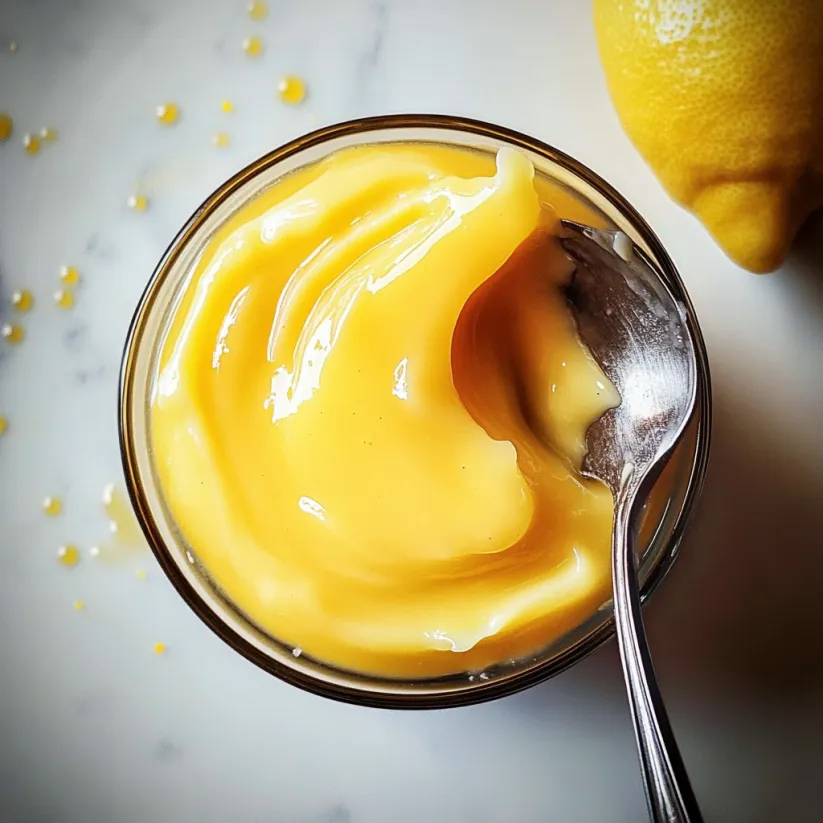 Save Pin
Save Pin
Homemade lemon curd brightens up everything from scones and pancakes to yogurt parfaits. This version is all about pure citrus flavor with a silky texture thanks to lots of fresh lemon juice and butter. It comes together faster than you think and makes a simple batch of sunshine to keep in your fridge.
The first time I made this lemon curd I could not believe how much better it tasted than anything from the store. Now my family asks for a jar in the fridge every week and it disappears on biscuits toast and sneaked by the spoonful.
Ingredients
- Granulated sugar: Brings sweetness and balances the lemon for that perfect tangy bite Look for fine pure cane sugar for the smoothest result
- Freshly squeezed lemon juice: Gives the curd its signature tartness Use firm heavy lemons with bright skin for maximum juice
- Lemon zest: Intensifies the lemon flavor since most of the aroma is in the zest Only zest the yellow part to avoid bitterness
- Large eggs: Thicken the curd and make it rich Choose the freshest eggs you can find preferably free range for better color and taste
- Unsalted butter: Adds creaminess for that luxurious silky finish European style butter is wonderful here if available
Step-by-Step Instructions
- Prepping the Lemons:
- Microwave the lemons for about twenty seconds to help release more juice Then roll them on your countertop with a firm hand to break up the pulp inside for easy juicing
- Zesting and Juicing:
- Use a Microplane or small grater to remove just the yellow zest from your lemons Avoid the white pith for the best flavor Then cut each lemon and squeeze until you have one cup of juice Strain it if you see seeds or pulp
- Mixing Ingredients:
- In a mixing bowl combine the lemon zest lemon juice and sugar Whisk vigorously until the sugar is dissolved Crack the eggs into a separate bowl then add them one at a time to your lemon mixture Be sure each egg is completely mixed in before adding the next
- Cooking the Curd:
- Pour your mixture into a heavy bottomed saucepan Place it over low heat and add the cubes of butter Stir constantly with a wooden spoon making sure to get into the corners and sides of the pot This prevents curdling and sticking Continue stirring as it gently heats The mixture should thicken so it coats the back of your spoon in about ten minutes
- Cooling and Storing:
- Once the curd has thickened immediately remove it from the heat Pour it into a clean glass jar or any container with a tight fitting lid Let it cool to room temperature then store it in the refrigerator for perfect texture and freshness
 Save Pin
Save Pin
My favorite part of this recipe has to be the zesty fragrance when grating the lemon zest My little one walks into the kitchen every time I make this because the aroma is so fresh and inviting Making lemon curd together has turned into a sweet weekend ritual for us
Storage Tips
Store lemon curd in a clean glass jar with a tight lid and keep it refrigerated It will last for a full week For longer storage lemon curd can be frozen in small containers and thawed in the fridge before using Be sure to stir well if the texture separates
Ingredient Substitutions
If you do not have fresh lemons limes can work in a pinch and create a delicious lime curd For a dairy free version swap the butter for plant based butter though the curd will set a little looser If you want a slightly less sweet result you can reduce the sugar by a quarter cup
 Save Pin
Save Pin
Serving Suggestions
Spread lemon curd on toast scones or use as a filling for cakes swirl it into yogurt blend into smoothies or fill tart shells Top pancakes waffles or French toast with a dollop for an easy breakfast upgrade It also makes a lovely edible gift when packed in a cute jar
History and Context
Lemon curd originated in nineteenth century England where it was served with afternoon tea alongside scones and biscuits Over time it became a classic filling for tarts and cakes The stovetop method used here ensures reliable results and a silkier curd compared to some older recipes that use double boilers
Commonly Asked Questions
- → Why is constant stirring important when cooking lemon curd?
Continuous stirring prevents the eggs from curdling and ensures an even, smooth texture throughout the curd.
- → Can I use bottled lemon juice instead of fresh lemons?
Freshly squeezed juice and zest provide the best flavor, but bottled juice can be used in a pinch, though with less brightness.
- → How do I know when the lemon curd is thick enough?
The curd is ready when it coats the back of a spoon, showing a clear line when you run your finger through it.
- → How should I store lemon curd after preparation?
Pour the finished curd into a jar, cool to room temperature, then refrigerate. For longer storage, freezing is also effective.
- → What are some ways to use lemon curd?
Lemon curd shines as a filling for tarts, swirled into yogurt, as a cake layer, or simply spread on toast or scones.
- → Why did my curd not thicken?
It may need more cooking time or slightly higher heat; also, as it cools, the curd will thicken further in the fridge.
